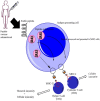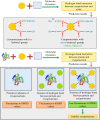Armamentarium of Cryoprotectants in Peptide Vaccines: Mechanistic Insight, Challenges, Opportunities and Future Prospects
- PMID: 34690621
- PMCID: PMC8524217
- DOI: 10.1007/s10989-021-10303-y
Armamentarium of Cryoprotectants in Peptide Vaccines: Mechanistic Insight, Challenges, Opportunities and Future Prospects
Abstract
Vaccines are designed to leverage the immune system and produce long-lasting protection against specific diseases. Peptide vaccines are regarded as safe and effective way of circumventing problems such as mild allergic reactions associated with conventional vaccines. The biggest challenges associated with formulation of peptide vaccines are stability issues and conformational changes which lead to destruction of their activity when exposed to lyophilization process that may act as stressors. Lyophilization process is aimed at removal of water which involves freezing, primary drying and secondary drying. To safeguard the peptide molecules from such stresses, cryoprotectants are used to offer them viability and structural stability. This paper is an attempt to understand the physicochemical properties of peptide vaccines, mechanism of cryoprotection under the shed of water replacement, water substitution theory and cation-pi interaction theory of amino acids which aims at shielding the peptide from external environment by formation of hydrogen bonds, covalent bonds or cation-pi interaction between cryoprotectant and peptide followed by selection criteria of cryoprotectants and their utility in peptide vaccines development along with challenges and opportunities.
Keywords: Cryoprotectants; Lyophilization; Peptides and proteins; Synthetic peptide vaccine.
© The Author(s), under exclusive licence to Springer Nature B.V. 2021.
Conflict of interest statement
Conflict of interestThe authors declare that they have no known competing financial interest.
Figures







Similar articles
-
Amino acids as cryoprotectants for liposomal delivery systems.Eur J Pharm Sci. 2007 Apr;30(5):406-13. doi: 10.1016/j.ejps.2007.01.001. Epub 2007 Jan 19. Eur J Pharm Sci. 2007. PMID: 17317117
-
Effect of the Freezing Step in the Stability and Bioactivity of Protein-Loaded PLGA Nanoparticles Upon Lyophilization.Pharm Res. 2016 Nov;33(11):2777-93. doi: 10.1007/s11095-016-2004-3. Epub 2016 Jul 21. Pharm Res. 2016. PMID: 27444681
-
The role of trifunctional cryoprotectants in the frozen storage of aquatic foods: Recent developments and future recommendations.Compr Rev Food Sci Food Saf. 2022 Jan;21(1):321-339. doi: 10.1111/1541-4337.12865. Epub 2021 Nov 11. Compr Rev Food Sci Food Saf. 2022. PMID: 34766434
-
Instability of therapeutic proteins - An overview of stresses, stabilization mechanisms and analytical techniques involved in lyophilized proteins.Int J Biol Macromol. 2021 Jan 15;167:309-325. doi: 10.1016/j.ijbiomac.2020.11.188. Epub 2020 Dec 1. Int J Biol Macromol. 2021. PMID: 33275971 Review.
-
Freeze-drying of live virus vaccines: A review.Vaccine. 2015 Oct 13;33(42):5507-5519. doi: 10.1016/j.vaccine.2015.08.085. Epub 2015 Sep 26. Vaccine. 2015. PMID: 26364685 Review.
Cited by
-
Predicting epitopes for vaccine development using bioinformatics tools.Ther Adv Vaccines Immunother. 2022 May 21;10:25151355221100218. doi: 10.1177/25151355221100218. eCollection 2022. Ther Adv Vaccines Immunother. 2022. PMID: 35647486 Free PMC article. Review.
-
Identification of natural peptides from "PlantPepDB" database as anti-SARS-CoV-2 agents: A protein-protein docking approach.Phytomed Plus. 2023 May;3(2):100446. doi: 10.1016/j.phyplu.2023.100446. Epub 2023 Mar 31. Phytomed Plus. 2023. PMID: 37033295 Free PMC article.
-
Poloxamer 188 stabilized poly (ε-caprolactone) microspheres of voriconazole for targeting pulmonary aspergillosis.Ther Deliv. 2025 Feb;16(2):155-166. doi: 10.1080/20415990.2024.2441647. Epub 2024 Dec 23. Ther Deliv. 2025. PMID: 39716773
-
Peptide Vaccines as Therapeutic and Prophylactic Agents for Female-Specific Cancers: The Current Landscape.Pharmaceuticals (Basel). 2023 Jul 24;16(7):1054. doi: 10.3390/ph16071054. Pharmaceuticals (Basel). 2023. PMID: 37513965 Free PMC article. Review.
-
Freeze-drying revolution: unleashing the potential of lyophilization in advancing drug delivery systems.Drug Deliv Transl Res. 2024 May;14(5):1111-1153. doi: 10.1007/s13346-023-01477-7. Epub 2023 Nov 20. Drug Deliv Transl Res. 2024. PMID: 37985541 Review.
References
-
- Alosaimi B, Hamed ME, Naeem A, Alsharef AA, AlQahtani SY, AlDosari KM, Alamri AA, Al-Eisa K, Khojah T, Assiri AM. MERS-CoV infection is associated with downregulation of genes encoding Th1 and Th2 cytokines/chemokines and elevated inflammatory innate immune response in the lower respiratory tract. Cytokine. 2020;126:154895. doi: 10.1016/j.cyto.2019.154895. - DOI - PMC - PubMed
-
- Arakawa T, Carpenter JF, Kita YA, Crowe JH. The basis for toxicity of certain cryoprotectants: a hypothesis. Cryobiology. 1990;27(4):401–415. doi: 10.1016/0011-2240(90)90017-X. - DOI
-
- Azevedo A, Cabral J, Prazeres D, Gibson T, Fonseca L. Thermal and operational stabilities of Hansenula polymorpha alcohol oxidase. J Mol Catal B. 2004;27(1):37–45. doi: 10.1016/j.molcatb.2003.09.001. - DOI
Publication types
LinkOut - more resources
Full Text Sources
Research Materials
Miscellaneous
